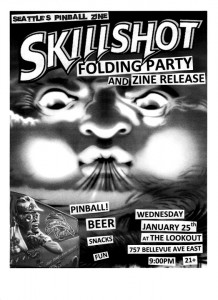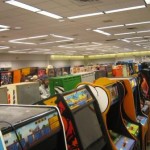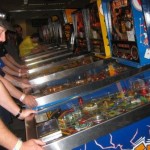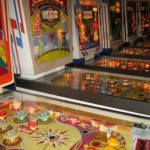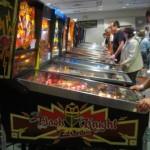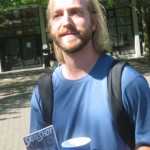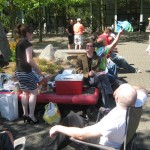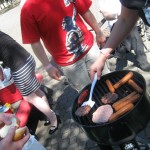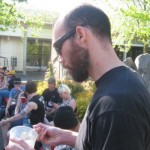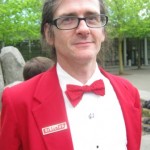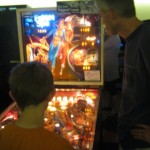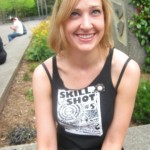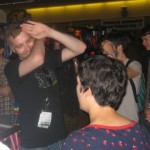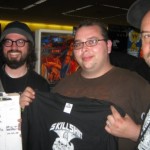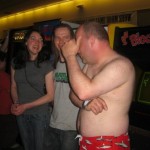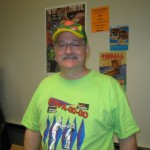Come help us fold the new issue. Check our Calendar for more details!
Category: other
Uncategorized
Dorky’s Valentine Day Couples Tournament  (Feb 14) 1. Gordon Brown and Amida Kunzi. 2. Couple unknown (contact SS and we will list you). 3. Jay Hatch and Amzeah Smith.
(Feb 14) 1. Gordon Brown and Amida Kunzi. 2. Couple unknown (contact SS and we will list you). 3. Jay Hatch and Amzeah Smith.
AC/DC Launch Party at Dorky’s (Feb 17) Division A. Jeff Gagnon. Division B. Eden Stamm.
AC/DC Tourney at Seattle Pinball Museum (Feb 18) 1. Dale Garbuth. 2. Barian Formosa. 3. Andrew Cole. 4. Matt Cohn.
Congrats to all!
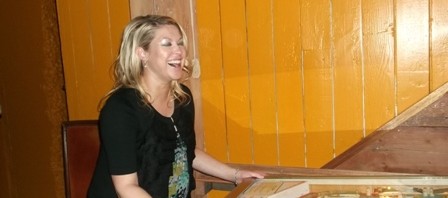
 Another excellent new way to play pinball with your friends: King for a Day! Here’s how to play: Go to a pinball-related event and find the host or person of honor. He/she then picks their favorite (or least favorite) pinball machine in the room and plays a one-player game on it. That person’s score is recorded as the King (or Queen) for a Day score. Contestants try to match that score in a one-player game. The contestant with the closest score wins! You can play for money (I like $1 buy-ins for 4 tries, winner-take-all) or prizes (bragging rights included). You can go over or under the King’s score, and the decision to allow tilting is up to the tournament official. It’s more fun to play on a game that the King or Queen dislikes (or is bad at) because the score will likely be low enough to allow for more inexperienced contestants to have a chance.
Another excellent new way to play pinball with your friends: King for a Day! Here’s how to play: Go to a pinball-related event and find the host or person of honor. He/she then picks their favorite (or least favorite) pinball machine in the room and plays a one-player game on it. That person’s score is recorded as the King (or Queen) for a Day score. Contestants try to match that score in a one-player game. The contestant with the closest score wins! You can play for money (I like $1 buy-ins for 4 tries, winner-take-all) or prizes (bragging rights included). You can go over or under the King’s score, and the decision to allow tilting is up to the tournament official. It’s more fun to play on a game that the King or Queen dislikes (or is bad at) because the score will likely be low enough to allow for more inexperienced contestants to have a chance.
King for a Day is a super-easy way to play and it’s usually a big hit. It works great at 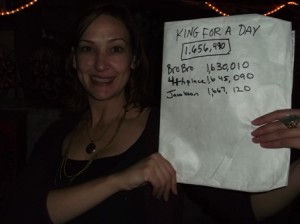 birthday parties (mine, won by King Micah Parrish, who took Sagel’s prize money and used it to get drunk), holiday get-togethers (Thanksgiving at Liberty House, won by Queen Katy Jacobson, who gave her prize money to Kevin Pittman to buy socks) and babyshowers, like the Add-a-Baby Tournament held at Headley and Claire’s and won by King Brian Chesbrough and Queen Katy Jacobson. And congrats to Simon and Stephanie Stocker on their new arrival!!
birthday parties (mine, won by King Micah Parrish, who took Sagel’s prize money and used it to get drunk), holiday get-togethers (Thanksgiving at Liberty House, won by Queen Katy Jacobson, who gave her prize money to Kevin Pittman to buy socks) and babyshowers, like the Add-a-Baby Tournament held at Headley and Claire’s and won by King Brian Chesbrough and Queen Katy Jacobson. And congrats to Simon and Stephanie Stocker on their new arrival!!
Bola Salvada!
Skill Shot Zine Release and Folding Party
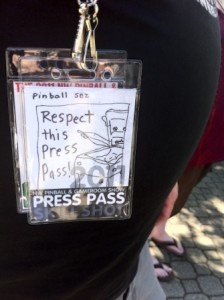
The Annual Northwest Pinball and Gameroom Show (PAGS) was held at Seattle Center again this year and it was bigger and better than ever! With over 400 pinball and arcade games, an exciting roster of guest speakers and seminars, and The Northwest Pinball Championships, it was a sensory overload of fun. Plus it was Seattle’s first warm and sunny weekend of the summer!
Unlike last year that had the pinball machines and arcade games in separate rooms, this year’s show had the two mixed together. It seemed a little unsettling for some pinball fans at first (no doubt because many remember that arcade games displaced pinball in the 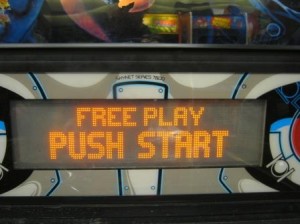 arcades back in the 80’s), but in the long run it was a welcome change and helped cement Seattle’s role as a city that embraces both communities of players and collectors. As far as we know, PAGS is unique as the only national expo that showcases both pinball and arcade games. We even played more arcade games this year because they were both in the same aisle and it was easy to play one while waiting for the other.
arcades back in the 80’s), but in the long run it was a welcome change and helped cement Seattle’s role as a city that embraces both communities of players and collectors. As far as we know, PAGS is unique as the only national expo that showcases both pinball and arcade games. We even played more arcade games this year because they were both in the same aisle and it was easy to play one while waiting for the other.
One of the cool pinball features this year was the complete collection of Williams System 11 pinball machines that took up two rows in the main room. There were 30 pins in this collection, beginning with High Speed (1986) and ending with Bugs Bunny Birthday Ball (1991). There were a lot of fun games in this collection including classics such as Pin-Bot, Cyclone, and Black Knight 2000, as well as pins we 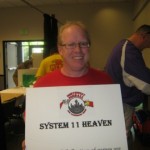 don’t get to play often like Swords of Fury and Earthshaker. Some of the games that we had never seen before (and fell in love with) included Grand Lizard, Big Guns, and Transporter the Rescue, all of which have cool artwork and playfields. The pins in this collection are owned by different area collectors and Seattle Pinball League President Rod Olson actually bought a Millionaire machine so that the collection would be complete!
don’t get to play often like Swords of Fury and Earthshaker. Some of the games that we had never seen before (and fell in love with) included Grand Lizard, Big Guns, and Transporter the Rescue, all of which have cool artwork and playfields. The pins in this collection are owned by different area collectors and Seattle Pinball League President Rod Olson actually bought a Millionaire machine so that the collection would be complete!
Another section of PAGS had a chronological collection of older (mostly) Gottlieb pins from the 1960’s and 70’s that showcased both the 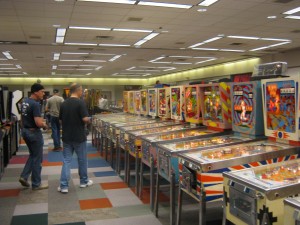 evolution of flippers, which became larger, and back glass art, which became rather surreal and psychedelic at times. A few of the standout pins in this section include Big Casino (1961) with its unique bottom bumpers (similar to Stern’s Wheel of Fortune) and games like Domino (1968) and Atlantis (1975) which show hip young people in unusual settings. Other older pins were also scattered around the hall, including the first flipperless pin to make an appearance at PAGS, an Exhibit Bounty (1938).
evolution of flippers, which became larger, and back glass art, which became rather surreal and psychedelic at times. A few of the standout pins in this section include Big Casino (1961) with its unique bottom bumpers (similar to Stern’s Wheel of Fortune) and games like Domino (1968) and Atlantis (1975) which show hip young people in unusual settings. Other older pins were also scattered around the hall, including the first flipperless pin to make an appearance at PAGS, an Exhibit Bounty (1938).
 Friday was a fun day to go to PAGS, as it was the day with the least amount of people so there was less waiting to play our favorite machines. Not everyone could take the day off from work, so there was no wait to play popular games like Theatre of Magic, Banzai Run or Black Hole, compared to the other two days. One game that did have a bit of a wait was the Seattle debut of the new Stern TRON pinball machine that was set up next to the Raffle Table. Not only did you have the chance to play the latest Stern pin, you also had a chance to win it if you were able to purchase one of the $20 tickets (limited to 250), which sold out rather early on Friday afternoon.
Friday was a fun day to go to PAGS, as it was the day with the least amount of people so there was less waiting to play our favorite machines. Not everyone could take the day off from work, so there was no wait to play popular games like Theatre of Magic, Banzai Run or Black Hole, compared to the other two days. One game that did have a bit of a wait was the Seattle debut of the new Stern TRON pinball machine that was set up next to the Raffle Table. Not only did you have the chance to play the latest Stern pin, you also had a chance to win it if you were able to purchase one of the $20 tickets (limited to 250), which sold out rather early on Friday afternoon.
Saturday had a larger crowd and was a good day for attending some of the seminars. Jack Guarnieri of Jersey Jack Pinball did a presentation on his company which is making The Wizard of Oz pin,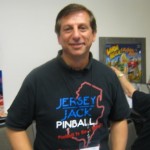 due to be released later this year. Another seminar featured John Youssi (Jokerz, White Water, TRON) giving us the rundown on how he began his career as album cover artist and made his way into becoming one of the most prolific pinball artists of the modern era. There were many other seminars during the weekend featuring talks by local champ Todd MacCulloch, pinball designer John Popadiuk (Circus Voltaire), artist Greg Freres (Scared Stiff and this years PAGS poster), designer John Borg (Guns N’ Roses), and many more, including “The Making of TRON Pinball”.
due to be released later this year. Another seminar featured John Youssi (Jokerz, White Water, TRON) giving us the rundown on how he began his career as album cover artist and made his way into becoming one of the most prolific pinball artists of the modern era. There were many other seminars during the weekend featuring talks by local champ Todd MacCulloch, pinball designer John Popadiuk (Circus Voltaire), artist Greg Freres (Scared Stiff and this years PAGS poster), designer John Borg (Guns N’ Roses), and many more, including “The Making of TRON Pinball”.
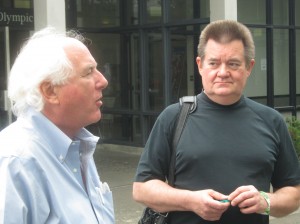 Gary Stern of Stern Pinball did a presentation about his company and family’s history in pinball. It was a fascinating rundown on how his father began as a coin-op distributor and eventually created a family-run business that became the only pinball manufacturer in the USA. Gary explained how the sales of Stern pinball machines break down into three main groups (operators, enthusiasts, home owners) and how 60% of the new Stern games are distributed outside of the USA (which explains Stern’s commitment to licensed themes). He also presented his theory on how games were becoming too complex for the casual player. Stern believes that making games easier to figure out and by adding more random features, pinball will become more appealing. He ended his talk lauding the social aspects of pinball by having fun events like tournaments and new pinball release parties. (And with pinball zines we might add.)
Gary Stern of Stern Pinball did a presentation about his company and family’s history in pinball. It was a fascinating rundown on how his father began as a coin-op distributor and eventually created a family-run business that became the only pinball manufacturer in the USA. Gary explained how the sales of Stern pinball machines break down into three main groups (operators, enthusiasts, home owners) and how 60% of the new Stern games are distributed outside of the USA (which explains Stern’s commitment to licensed themes). He also presented his theory on how games were becoming too complex for the casual player. Stern believes that making games easier to figure out and by adding more random features, pinball will become more appealing. He ended his talk lauding the social aspects of pinball by having fun events like tournaments and new pinball release parties. (And with pinball zines we might add.)
Saturday afternoon was the second annual Guerilla BBQ outside on the plaza, hosted by Claire and Headley. With the Space Needle as a backdrop, wieners and burgers were grilled to order and several side dishes were shared during this delicious break from all the pinball festivities. You didn’t have to be a local gamer to partake in the food, as a few homeless men soon found out, as well as Jeff Brownsberger from Georgia, who won tickets and airfare to the show from the PAGS website! Eventually a representative of the Center showed up and asked for the grill to be shut down, but mostly everyone was already fed. Did we mention that it was a gorgeous day?
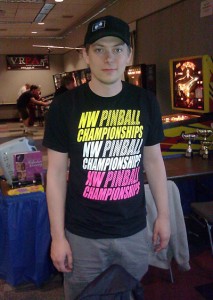
Saturday evening had the biggest crowds of the weekend and it was sometimes a bit of a wait to play a popular pin. This was the best time to play the games that might otherwise be ignored, like the kid-size Punchy The Clown, the unwieldy Algar, and the unusual (but fun to look at) Orbitor 1. Meanwhile, a lot of contestants were trying to get good scores to place in The Northwest Pinball Championships, up until the midnight closing time. Graham and Cayle worked together to get the results on the Skill Shot website so the finalists would know to be back at the tournament before the noon start time. We are not sure that all of the contestants knew that we were going to do this, but we want to make this a regular thing, so watch for it to happen again next year.
Sunday was the last day of PAGS and also Skill Shot’s Biggest Loser Tournament! The two hour Biggest Loser event was held on Headley’s Future Spa, which fortunately had extra space around it due to Space Invaders being commandeered for the main tournament. Hosted by Bernard Boulevard, contestants were invited to try to get the lowest score possible without tilting! There was a lot of interest from people who had seen our posters as well as people passing by who were attracted by all the excitement. Biggest Loser is harder than it sounds when playing on a game like Future Spa. You never knew who was going to get the lowest score: a seasoned player, a shirtless Aaron McAbee, or perhaps the young kid hanging out with his dad. Ultimately Lee Hopson of Tacoma walked away with the lowest score and a Skill Shot T-shirt!
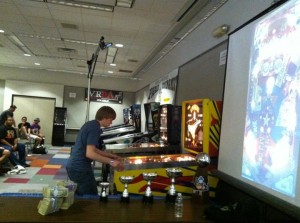
As PAGS wound down for its 3PM closing time on Sunday, and people scurried around for some last minute pinball playing, The Northwest Pinball Championship Finals was entering its exciting conclusion. 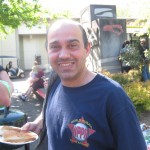 This is the largest pinball tournament in the region, with a big cash prize, so players from all over the area (and beyond) come to compete. Earlier in the day the tournament had the final playoffs for the Women’s Championship (won by Seattle’s Linda “Cheeseboat” Nasfell), the Classics Division (won by New York’s Francesco LaRocca), and the Novice Competition (won by Mercer Island’s Eric Dubofsky). Some of the players for the main tournament included Keith Elwin from Carlsbad CA, Zach and Josh Sharpe from Chicago IL, various members of Portland’s CFF crew and local favorites like Robert Gagno, Maka Honig and Cayle George. When all other locals had been defeated, Raymond Davidson from Mukilteo WA was the lone Seattle Pinball League member left in the contest. Raymond showed that he was a pinball force to be reckoned with when he tied number one ranked Elwin for first place and the $2,400 grand prize! Ultimately Elwin was able to wrest the first place win from the young upstart during a nail-biting tie breaker on Supersonic. Dang!
This is the largest pinball tournament in the region, with a big cash prize, so players from all over the area (and beyond) come to compete. Earlier in the day the tournament had the final playoffs for the Women’s Championship (won by Seattle’s Linda “Cheeseboat” Nasfell), the Classics Division (won by New York’s Francesco LaRocca), and the Novice Competition (won by Mercer Island’s Eric Dubofsky). Some of the players for the main tournament included Keith Elwin from Carlsbad CA, Zach and Josh Sharpe from Chicago IL, various members of Portland’s CFF crew and local favorites like Robert Gagno, Maka Honig and Cayle George. When all other locals had been defeated, Raymond Davidson from Mukilteo WA was the lone Seattle Pinball League member left in the contest. Raymond showed that he was a pinball force to be reckoned with when he tied number one ranked Elwin for first place and the $2,400 grand prize! Ultimately Elwin was able to wrest the first place win from the young upstart during a nail-biting tie breaker on Supersonic. Dang!
What a great way to end the weekend.
As promised, here are the results for the Open and Classics finals tomorrow at the Northwest Pinball & Gameroom Show. Thanks to Cayle for helping make this happen so easily.
NW Pinball & Gameroom Show!
This weekend marks the annual Northwest Pinball and Gameroom Show held at the Seattle Center. Be there. We will!
- Come find us to buy your own new Skill Shot shirt!
- Check back here at Skill-shot.com Saturday night and Sunday morning for a list of the finalists at the Pinball & Gameroom Show’s pinball tournaments!
- Play our Biggest Loser Tournament from noon to 2 PM on Sunday on Future Spa! Don’t know how to play Biggest Loser? It’s easy. Just read about it here or in Skill Shot #19. Free to enter!
See you all down there.
Skill Shot recently spoke with Jay Stafford of Seattle, the Senior Editor of the Internet Pinball Database at http://www.ipdb.org. Jay, along with Chris Wolf (who manages the technical end), have been the driving force behind the IPDB since 2002. Working with over 1,500 contributors, they’ve built the Wikipedia of pinball, with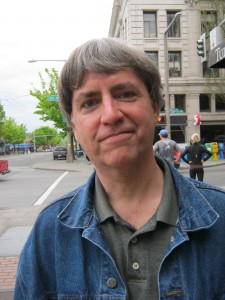 an average of 5,000 to 6,000 unique visitors daily. You can find the entire hour-long interview here. Below is an excerpt regarding the emergence of “re-themed” games.
an average of 5,000 to 6,000 unique visitors daily. You can find the entire hour-long interview here. Below is an excerpt regarding the emergence of “re-themed” games.
SS – You say you only want to have pictures of the games in factory conditions. How can you tell?
JS – It’s an art sometimes, how to tell. A lot of it is trust, but a lot of it isn’t. I get pictures of a game, especially older games, beat up around the corners. I doubt they were recently painted. Reproduction parts can be a little harder. But by and large people are very upfront about it. Where I might have a problem is we have a European audience and not everybody speaks English. And therefore I think that they don’t benefit from ongoing conversations [online] or maybe they can’t read our pages that say, you know, don’t send us paint jobs. Sometimes I get well-meaning people that will send us pictures that are obviously beautiful repaints, but we can’t use them. Sometimes people will say, “I restored this game and I thought you’d want to have pictures”, and they’re very proud of what they’ve done – and they ought to be! I’ll ask them, “what do you mean by restored? Is it just a good cleaning and a rubber changing, or did you actually get out a brush and start doing things?” And they’ll tell me.
SS – Is that what you’re trying to avoid, if somebody’s painting the machines…
JS – Yeah, we’re trying to show factory condition. Although people can actually repaint their games and restore them to be probably identical to factory, I’m getting pictures of them, and there’s already a color translation in that, I imagine, but more so we want people to come to our site and believe they’re looking at factory condition, and not wonder if some collector had decided this is the color that belongs.
The other thing is if we allow repaints, we probably would be receiving a lot of people’s repaints to show everybody how well they can repaint. Some people do it for commercial reasons, some people do it because they’re really proud of what they’ve done. I’m not against restoring at all. But as far as what we put on the database, we don’t want repaints and anything that didn’t come from the factory.
SS – I guess there isn’t a limit on how many have to come from the factory. Galactic Girl, for example. There’s a production of 1, but because it’s an original game and it’s not a modified older game…
JS – Oh yeah. Here’s the thing on that. Up until a few years ago it was very rare to see anyone take a factory-made game and repaint it and give it a brand new theme. It wasn’t an issue. But lately there’s been an explosion in the hobby of people who want to “re-theme” their games. Totally repaint it, change it. And they have the facility and the talent to do that and make it look as professional as if it came from the manufacturer. They may only make one, they may make a few, whatever, but those games get exposure, and people will come to our website eventually and they’ll want to learn more about that. And if we don’t show those re-themed games on our website, then for one, we’re probably not performing the service we should be, and for two, people might think, well we need to be told about it. So what we decided to do is create a category on the pinball database and call it “re-themed games”, so these ones that aren’t manufactured, we’ll put them up on the website, if nothing else so when people go to look they’ll at least see, okay, they’re aware of it, and it’s a re-themed game, and it’s not a historical manufacturer-produced game, meaning manufacturers that we know: Stern, Bally, Gottlieb, and the zillions that came before. You know, Galactic Girl [wasn’t] made by a historical manufacturer, it was made by a hobbyist or a collector.
SS – A private artist.
JS – Right.
SS – Like there’s that Bill Paxton one, I don’t know if you’ve seen that.
JS – I have, and we have it up [on the site.] So in showing those games, we’re breaking our own rules. But we feel we had to, again, because we wanted to not have people come to us and not be satisfied. So what we do for those re-themed games is we make them unique and we show a modicum of information, just a few pictures, yeah, this is what it is. But we don’t feature it in full bloom. We really don’t want to become commercialized by people who might some day say “I want to sell these.” We don’t really want the commercialization of the site. To become someone’s showroom, maybe they should host their own pictures if they’re doing it for business purposes. So it’s a slippery slope there, but I think we’re keeping a handle on it.
SS – There are different ways of doing it. Dominique built his own playfield, but there are some people who just take the playfield and just change the artwork or the theme.
JS – You get it all. You get people who design the complete playfield. I think we have a game [where] the guy made his own parts! Now how exactly — I don’t know if he wound his own coils, I can’t say. And then others just will simply take a game, sand down the playfield to nothing, and then paint it over again. And how they do the backglasses, I’ve never asked them. But I’ve had silkscreened ones, and ones that are just translucent, like a translite.
Within the last few years I’ve seen more than I’ve ever seen in all the years before that. The hobby’s exploding. It isn’t just people collecting games and sticking them in their basement. I think that men like to work with toys, machines and tools, so after awhile it’s not enough to own them, you want to do things to them. And so we start to do things, and we get more emboldened by our successes and sharing the tips in how you do this and that. And before you know it, well, we have what we have, we have a lot of people who know how to restore really well. Having these games out there, it’s only natural in the way the hobby’s going. The fact that we stick with the original means that we’re not in step with that part of the hobby.
SS – Which is a little bit different from, wasn’t it during WWII, where their resources were rationed, the companies would take their games and re-theme them themselves?
JS – I’m glad you brought that up! And we thought about that, “what’s the difference there?” Well, for one, they’re historical, for two, they’re dead and they’re not trying to make money, you know, so we can find a way to draw the line there.
SS – They probably also made more than one.
JS – Oh yeah, they did plenty. They advertised in Billboard and places like that, so, we still view them as historical manufacturers. Even though there may be a company that only did one and folded! [laughs] But yeah, they did do re-themed games. But we called them “conversions” back then. Today’s stuff are “re-themed.” Those are “converted” now. We can mince words but that’s the separation we’re giving it.


